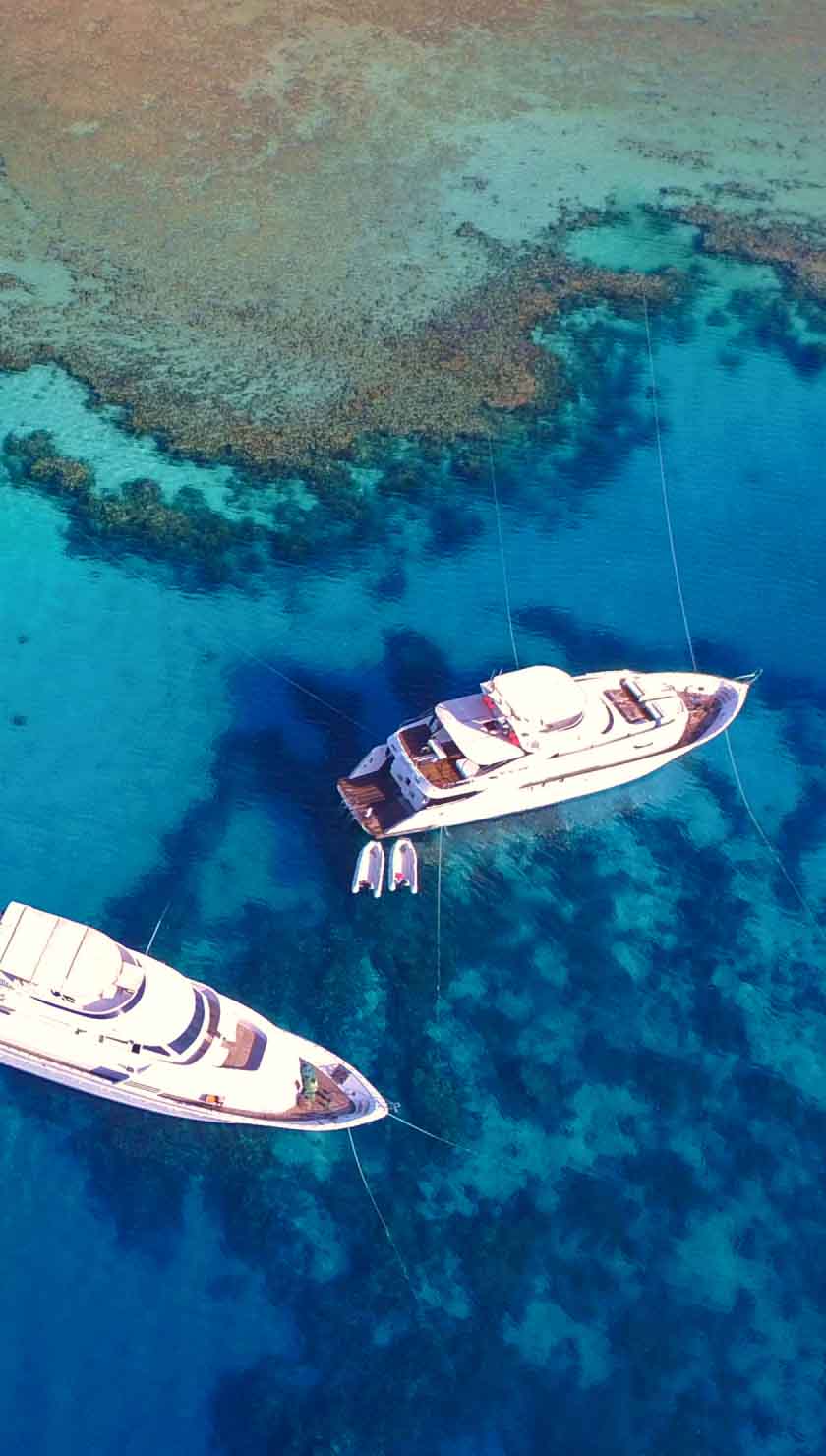Liveaboard Diving in Shark Cave
What To Expect On a Shark Cave Liveaboard
Liveaboards to Shark Cave offer divers the chance to dive one of the top Mergui Archipelago dive sites. Myanmar liveaboards don’t get much better than this. Sailing 2 km north of Great Swindon Island, 75 km from Kawthaung, a chain of three islands appear. Called either Three Islets or Three Stooges and more commonly called Shark Cave by Myanmar dive cruise operators. In sharp contrast to the bare rocks that identify this site at the surface, a liveaboard to Shark Cave will surprise you with its abundance of marine life.
The island, being the largest at 100 meters wide and middle of the three islands, has made the dive site famous. On the northwest corner of the island at 5m below the surface, the cave starts as a large cavern entrance and drops down to 16m. The cavern gradually narrows inside, forming a tunnel about 20m long, through to the east side of the island. There is a smaller tunnel chamber accessed by a meter wide hole. Surge can make navigating the tunnel tricky at times. In the tunnel area, we recommend a torch to see into the deeper crevices.
This is also an excellent spot for a night dive whilst on your Shark Cave liveaboard. The southernmost rocky outcrop of the three islets is called The Pinnacle and drops down below 30m. If currents permit, they can be strong at times, it’s small enough to circle in a single dive. To the north of the shark, cave island is a small rocky outcrop called Square Rock. Although tiny above water, it expands below the surface. The wall drops vertically down to about 15m before sloping out to the sand at 28m deep.
What You Can See at Shark Cave
During your Shark Cave liveaboard, you will have plenty of time to explore this wonderful area. In the shallows, magnificent anemones add color, as do Clark's and tomato anemone fish and the western clownfish. Shark Cave is known for its resident docile nurse sharks. The ragged cave entrance often found crowded by several long-fin trevally, silver sweetlips and grey reef sharks. They come to hunt for the masses of juvenile barracudas, cave sweepers, and silversides. The ceiling of the 20 meters long tunnel is covered in beautiful marigold cup corals and the floors with yellow Stylotella Aurantium sponges. Cruising through the tunnel sometimes grey reef shark can be met, which can get hearts pounding a little faster, the best policy is to stay low and stick close to one side of the tunnel to give them space to get past. Swimming through the cave you will notice the highly decorated floor (yellow sponges) and ceiling (marigold cup corals). Despite the sharks, the devil is in the detail here with Durban dancing shrimps, lobsters, moray eels, cowries, sea slugs, and more all adding to the entertainment.
In the cracks in the wall are hidden nocturnal grey bamboo sharks, a small species about half a meter in length, as well as rock lobsters and frogfish. Groups of white tip reef sharks can also make a surprising appearance. A 1-meter square hole marks the entrance to the lower cavern where nurse sharks can be seen. It is accessible 1 diver at a time and real care is needed with buoyancy control. Most divers exit the tunnel on the east side and turn left to the north where a sloping reef down to 25m is covered with hard and soft corals, green tube corals and cup corals, sea fans, black and white feather stars. Black-blotched fantail rays and black and white banded sea snakes hunt over the reef. Have a close look at the reef to spot yellow ornate or harlequin ghost pipefish and tigertail seahorses. Don’t forget to look out for bent stick pipefish on the sandy bottom. At night there are decorated sponge crabs, these masters of disguise turn their back on you, and you could well think that you are staring at a lump of sponge. The southwest wall bottoms at 30 meters and has many fine crevices crammed full of life. Take a careful look and you'll see Durban dancing shrimps and red and white banded boxer shrimps on the ledges, mantis shrimps, sea slugs, cowries, and an amazing amount of moray eels, snowflake, white-eyed and fimbriated. If you're lucky, you could see the feeding habits of cuttlefish. They hunt in pairs; one acts as a look-out, as the other frantically searches in the crevices with its tentacles to pull out any food it can find.
Getting To Shark Cave
To get to Shark Cave this is best done from a Myanmar liveaboard safari, which will depart from Phuket, Khao Lak, and Ranong in Thailand. Direct flights from Bangkok to Ranong, on the Thai side of Myanmar, are available through Bangkok Airways. Then you can take a taxi directly from Ranong Airport to the port of departure.
Yangon International Airport, the main hub for domestic flights, can be accessed by local airlines, which include Air Bagan and Myanmar National Airlines. Most travel agencies in Yangon, Mandalay, and Bagan can arrange cars and drivers.











